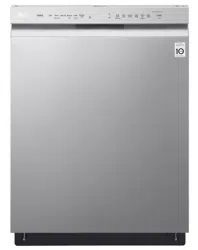Documents: Go to download!
- Owner's manual - (English, Spanish)
- PRODUCT OVERVIEW
- INSTALLATION
- OPERATION
- MAINTENANCE
- TROUBLESHOOTING
Table of contents
OWNER'S MANUAL LG DISHWASHER
PRODUCT OVERVIEW
Exterior Parts

- Control Panel & Door Handle
- Front Cover
- Lower Cover
- Shipping Brace
- Safety Cover
- SignaLight™ (some models)
- Base
- Leveling Feet
NOTE
- Do not remove the safety cover at any time.
- To ensure reliability, each LG dishwasher goes through thorough quality control before it leaves the factory.
- You may find water droplets or water spots from this process inside your new dishwasher.
SignaLight™ (Front Display)
The top-control models have 3 indicator LEDs centered at the top of the front cover.
- Red : Error (See the Error Codes in Troubleshooting section.)
- White (steady): Normal operation.
- White (blinking): Cycle has been paused. (After four minutes in pause mode, the machine turns off.)
- Green: Cycle finished normally.
The default “ON” setting keeps the green light on until the door is opened. If the setting is changed to “OFF”, the green light turns off after 90 seconds. To change the setting, turn the power on and press and hold the High Temp button for 3 seconds until “ON” or “OFF” appears in the display. The setting is stored until you change it.
Interior Parts

- Top Wash Impeller
- Upper Spray Arm
- Lower Spray Arm
- Filtration System
- Detergent and Rinse Aid Dispenser
- Drying Vent Cover
- Upper Rack
- Silverware Basket
- Lower Rack
NOTE
- The silverware basket ships installed at the back of the bottom rack. For best performance, install it along the right side as shown in the Interior Parts section.
- Remove all packing materials from the exterior and interior of the dishwasher before installing the appliance
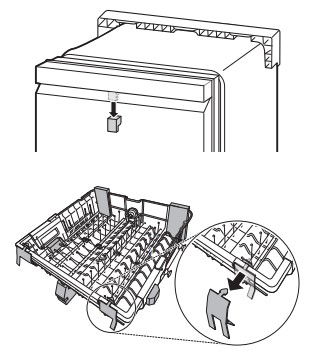
- Press the tab to remove the cable tie by hand. Cutting the tie with a knife or scissors may damage the rack or the silverware basket.
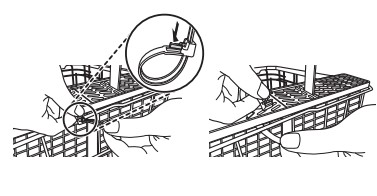
Accessories
Included Accessories

INSTALLATION
Installation Parts and Tools
Parts not Provided
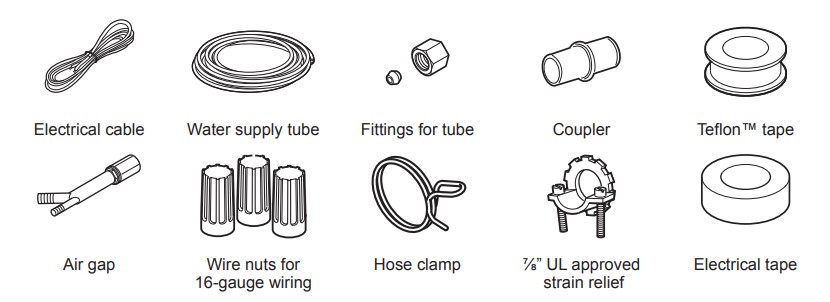
Tools Needed
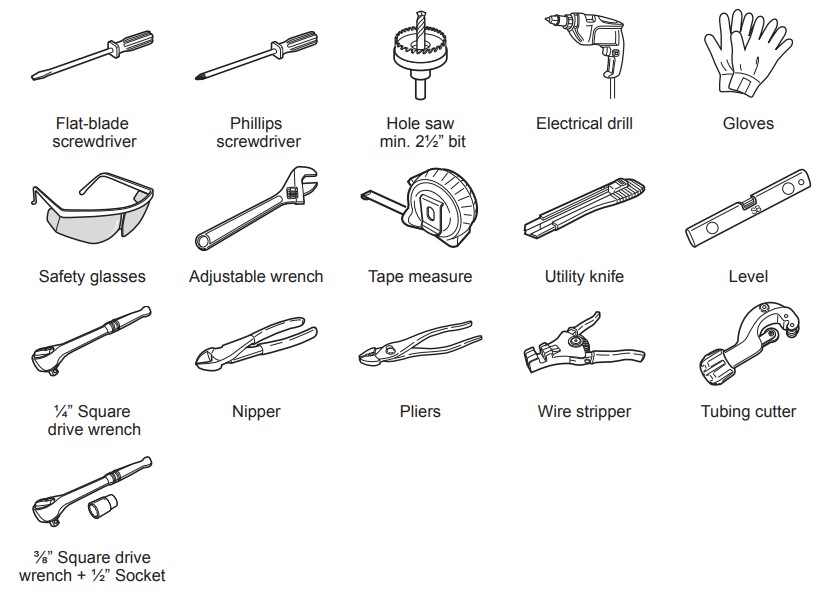
Installation Overview
- Preparing Cabinet Opening
- Preparing Electrical Wiring
- Preparing Water Supply Connection
- Preparing the Dishwasher
- Removing Lower Cover
- Sliding the Dishwasher into Cabinet
- Leveling the Dishwasher
- Securing the Dishwasher to Countertop
- Connecting the Drain Hose
- Connecting Water Supply
- Connecting Power
- Final Check
Product Dimensions
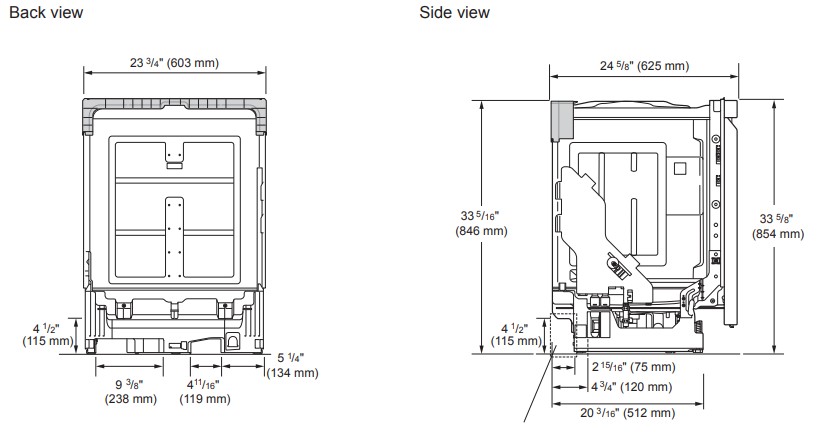
Water supply hose, drain hose and electric cable should be passed through this area.
NOTE: For easiest installation, see marked areas above for water and electrical clearances in base of dishwasher.
Product Specifications
The appearance and specifications listed in this manual may vary due to constant product improvements.
| Electrical requirement | 120 V, 60 Hz AC only, minimum 15 A circuit breaker |
| Water pressure | 20 - 80 psi (140 - 550 kPa) |
| Dimensions | 23 3 /4"(W) X 24 5 /8"(D) X 33 5 /8"(H) 603 mm(W) X 625 mm(D) X 854 mm(H) |
| Inlet water temperature | 120 °F (49 °C) minimum, 149 °F (65 °C) maximum |
| Net weight | 75 lbs. (34 kg) |
Preparing Cabinet Opening
This dishwasher is designed to fit a standard dishwasher opening. An opening may be needed on both sides to route plumbing and electrical connections.
- To ensure proper drainage, install the dishwasher no more than 12 ft. (3.65 m) from the sink.
- The location must have sufficient space for the dishwasher door to open easily and provide at least 0.1” (2 mm) between the dishwasher and the cabinet sides.
- If installing the dishwasher in a corner, leave a minimum of 2” (50 mm) between the dishwasher and the adjacent wall.
- The adjacent wall must be free of obstructions.
- For flush installations only, you may remove the cabinet brace (1) inside the cabinet.
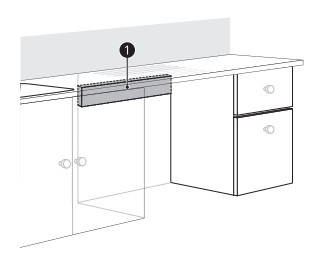
- Select a location as close to the sink as possible for easy connections to water supply line, drain hose and electrical connection.
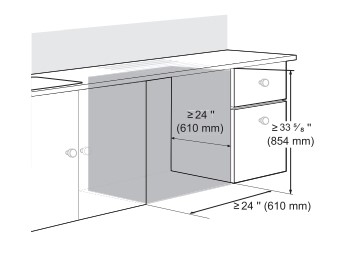
- To allow for proper clearance of plumbing and electrical, use the template included with the literature to determine the clearance on the side of the cabinet where the cabinet meets the back wall. Using a 2 1 /2” diameter hole saw, drill a hole in the target area as shown on the template.
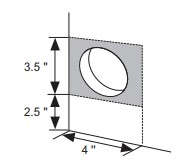
Preparing Water and Electrical Connections
There are 2 channels in the bottom of the dishwasher for routing the water and electrical connections. As shown in the bottom view below, channel (1) is for the water supply line, and channel (2) is for the electrical cable.
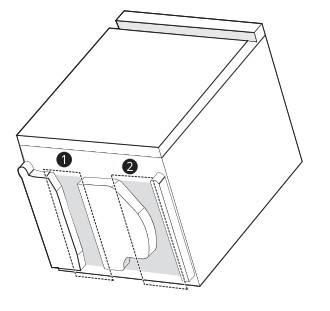
- Turn off the house water supply and the circuit breaker or dedicated power before connecting the dishwasher.
- Run the water supply line along the floor 6 1 /2 – 7 3 /4” (165–197 mm) from the left side of the opening and tape it in place in front of the opening.
- Run the electrical cable (3) along the floor 14–16” (356–406 mm) from the water supply (4) line and tape it in place.
- The electrical outlet must be within 4 ft. (1.22 m) of either side of the dishwasher.
- The best location for the electrical conduit is on the right side of the back wall. Re-route the electrical cable before installation if the electrical conduit pipe is longer than 3” (76 mm) and is centered on the back wall.

Preparing Dishwasher
WARNING : Do not remove safety cover (1) . Removal can result in fire, electric shock or death.
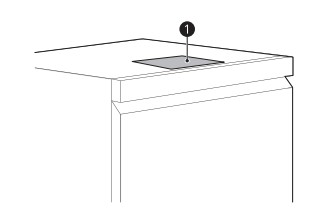
Releasing Drain Hose
Remove the twist tie holding the drain hose to the back of the shipping brace.
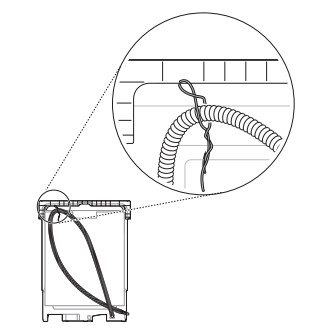
Removable Shipping Brace
The rear shipping brace can be removed if additional clearance is needed when installing the dishwasher under a low countertop
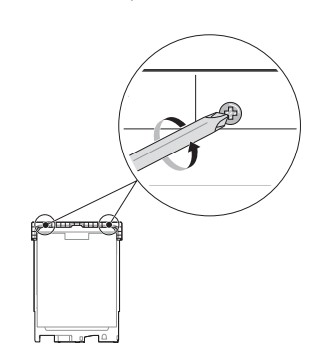
Removing Lower Cover
- Remove the screws at either side which attach the lower cover to the dishwasher.
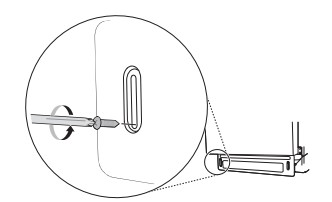
- Remove the lower cover.
- If there is insulation padding behind the lower cover, remove it.
- Set the parts aside until the installation is complete.
Removing Packing Materials from the Interior
Remove all packing materials from the interior of the dishwasher before installing the appliance.
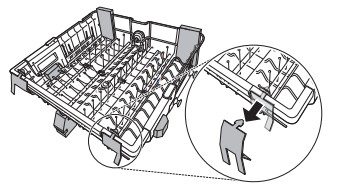
Attaching Installation Brackets
For countertops made of wood or other material that will not be damaged by drilling, use the metal installation brackets provided. For countertops made of granite, marble, or other materials that could be damaged by drilling, use the wood screws to attach the dishwasher to the cabinet. See installation instructions in Securing Dishwasher to Cabinet Opening.
NOTE
- Installation brackets and screws can be found in the silverware basket.
- Insert the tabbed end of the installation brackets into the slots in the upper frame. Rotate the brackets until the tabbed ends are facing up
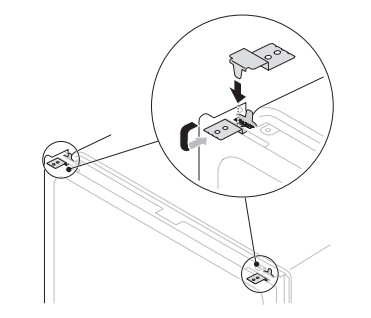
- Bend the tabs on the brackets to secure them to the frame using a pair of needle nose pliers.
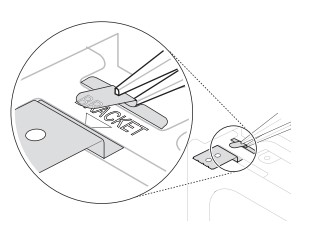
Sliding Dishwasher into Cabinet Opening
NOTE
- Open the door and grab the body frame and the top front opening (2) of the tub to move or lift the dishwasher.
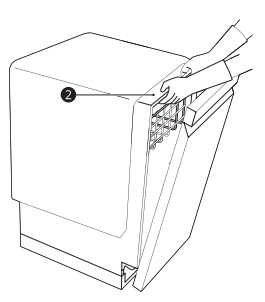
- Align the dishwasher with the opening. Make sure the water supply line and electrical cable are in the correct positions to slide into their channels properly.
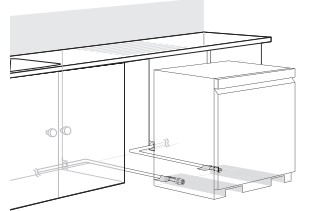
- Smooth out or pad the edges of the hole drilled for the water supply to avoid damaging the drain hose.
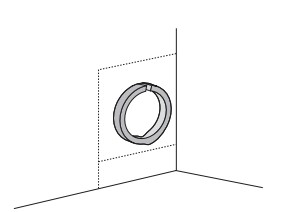
- Make sure the drain hose is straight before feeding the end of it through the hole for the water supply. As you slide the dishwasher into the opening, you will want to slowly pull on the drain hose from inside the cabinet to take up some slack. Be careful not to kink, pinch, crush or stress the drain hose during installation to avoid leaking and water damage.
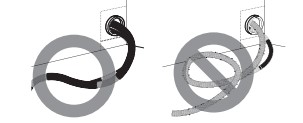
- Gradually slide the dishwasher into the opening, making sure that the water supply line and electrical cable are passing freely through the channels and do not get caught under the dishwasher. As you slide the dishwasher into the opening, stop periodically (or have an assistant help) to take up the slack by pulling the drain hose farther into the cabinet.
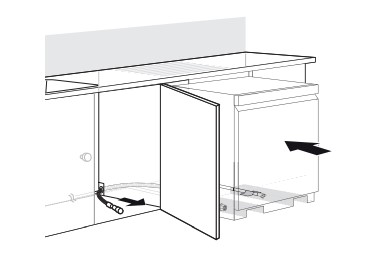
- Remove the tape from the water supply line and the electrical cable.
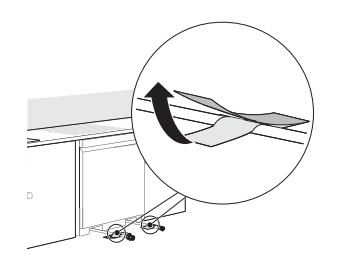
Connecting Water Supply Line and Power
Connecting Water Supply Line
- With the home water supply turned off, connect the water supply line to the inlet valve on the left front of the dishwasher.
- Tighten the compression nut.
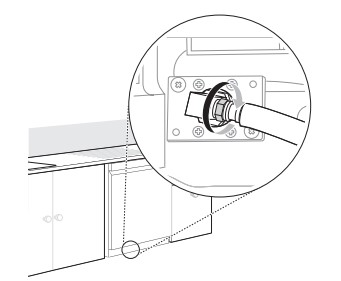
- Slide the water supply line back through the channel, pulling gently from inside the cabinet to make sure the line is not kinked, pinched, stressed or crushed
Connecting Power
The dishwasher should have a dedicated properly grounded branch circuit to connect the 3 wire setup which includes the ground wire. If a 3-prong power supply is used, it should be in an accessible location adjacent to the dishwasher within 4 ft. (1.22 m) of the dishwasher side and not behind the dishwasher.

NOTE: The best location for the electrical conduit is on the right side of the back wall. Re-route the electrical cable before installation if the electrical conduit pipe is longer than 3” (76 mm) and is centered on the back wall.
- Turn off electrical power to the unit at the circuit breaker.
- Use a Phillips screwdriver to remove the screw from the junction box cover and remove the cover

- Slide a strain relief (1) onto the end of the electrical cable.

- Insert the strain relief (1)and the electrical cable through the hole in the junction box. Tighten the ring nutc(2) to secure them in place.
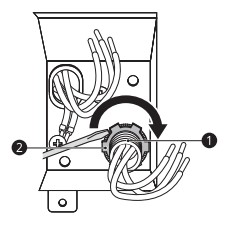
- Pair the white, black, and green wires to the matching colored wires from the dishwasher. Then twist on the provided wire nuts (3) tightly to connect the corresponding wires.
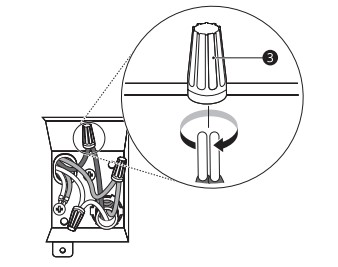
- Wrap electrical tape (4) around each connection.
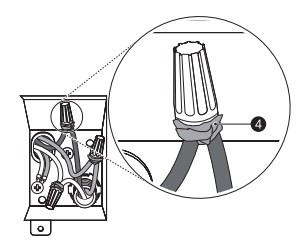
- Fold the connected wires back into the junction box and screw on the junction box cover.
Connecting Drain Hose
If the end of the drain hose does not fit the drain line, use a heat and detergent resistant adapter (not supplied). These may be obtained from a local plumbing supply store.
- Cut the adapter so the end matches the size of the drain connection.
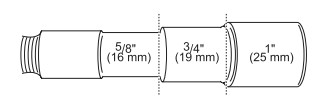
NOTE
- For drain hose installation, use the screw style hose clamp provided with this dishwasher in the silverware basket.
- If connecting the dishwasher’s drain hose to the garbage disposal, be sure to follow your garbage disposal’s manual for proper installation instructions.
Drain Hose Requirements
- Follow local codes and ordinances.
- Do not exceed 12 ft. (3.65 m) distance to drain.
- Do not connect drain hoses from other appliances to the dishwasher’s drain hose.
- If an extension drain hose is required, use a 5/8” or 7/8” inside diameter, 2-3 ft. length hose and a coupler (1) for connecting the two hose ends.

Connecting to Disposal without Air Gap
The height of the drain hose end must be at least 12” (305 mm) and within 40” (1016 mm) from the base of the dishwasher to avoid water being siphoned from the tub.
- Remove the knockout plug on the disposal with a hammer and screwdriver.
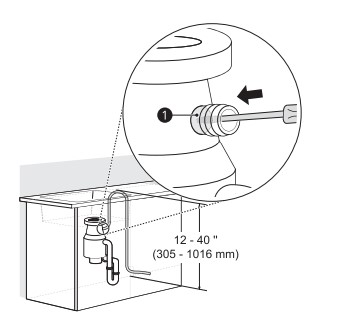
- Remove the knockout plug from the disposal.
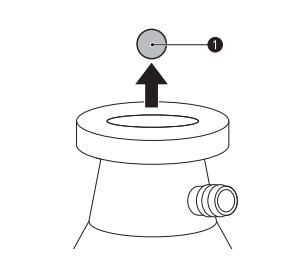
- Attach the drain hose to the disposal with the hose clamp provided. Move the hose clamp into position and tighten it with a flat-blade screwdriver.

Connecting Waste Tee without Air Gap
The height of the drain hose end must be at least 12” (305 mm) and within 40” (1016 mm) from the base of the dishwasher to avoid water being siphoned from the tub.
- Remove the knockout plug with a hammer and screwdriver.
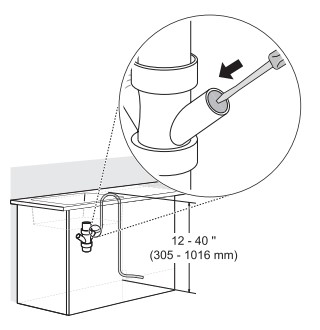
- Attach the drain hose to the waste tee with the hose clamp provided. Move the clamp into position and tighten it with a flat-blade screwdriver.
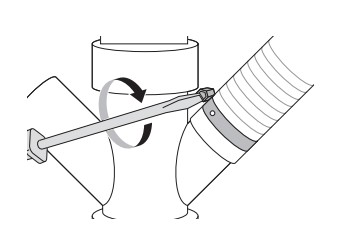
Connecting to Disposal or Waste Tee with Air Gap
- Remove the knockout plug with a hammer and screwdriver.
- Connect the end of the drain hose to the air gap with the hose clamp provided. Move the clamp into position and tighten it with a flat-blade screwdriver.
- This avoids water being siphoned from the tub.
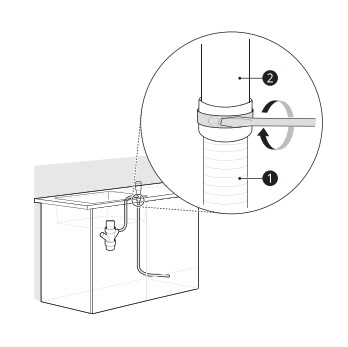
- This avoids water being siphoned from the tub.
- If it is not connected, attach the rubber hose connector to the disposal or waste tee with a hose clamp (not provided).
Leveling Dishwasher
Check that the dishwasher is level and adjust the leveling feet if necessary.
Checking Leveling
To check that the tub is level from front to back, remove the lower rack and pour 169 oz. (5 L) of water into the bottom of the tub. The water level should be near the center of both tub lower indentations at the front.
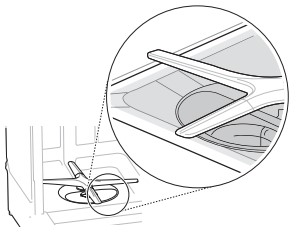
With the lower rack removed, place a level on the inside wall of the tub to check that the dishwasher is level from side to side.
- If you do not have a level, try using a smartphone level application instead.
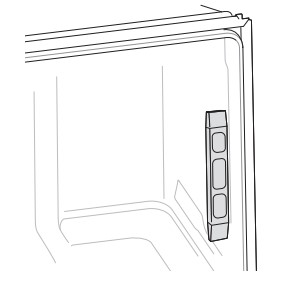
Make sure that the gap between the tub walls and the door liner is the same on either side.
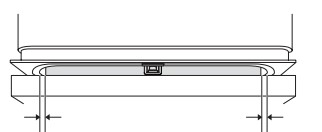
Adjusting Leveling Feet
Adjust as needed until the dishwasher is completely leveled. Adjusting Front Leveling Feet
Use a flat-blade screwdriver to turn the front leveling feet and adjust the front of the tub.
- Turn the front leveling feet clockwise to raise the front of the tub and counterclockwise to lower it.
- The adjustments work identically for both front leveling feet.
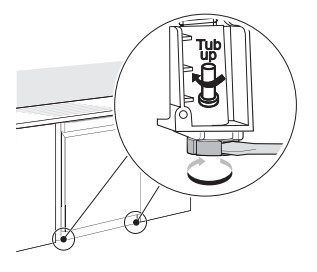
When the flat-blade screwdriver is unavailable, use a ¼” square drive wrench (1) or ⅜” square drive wrench (2) with ½” socket (3) to turn the front leveling feet and adjust the front of the tub.
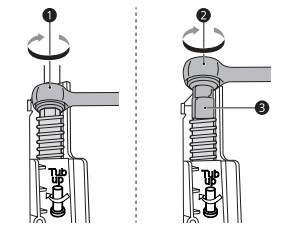
Adjust the front and rear leveling legs until they are all in firm contact with the floor. Failure to level the dishwasher may prevent the door from closing properly and the dishwasher will not turn on.
Adjusting Rear Leveling Foot
- Use a Phillips screwdriver to adjust the rear leveling foot and the rear of the tub using the center screw at the base of the appliance in the front.
- Turn the center screw clockwise to raise the rear of the tub and counterclockwise to lower it.

NOTE: To avoid damaging the screw, do not use an electric screwdriver.
Securing Dishwasher to Cabinet Opening
There are 2 options for securing the dishwasher. If the countertop is made of wood or a material that can safely be drilled into, secure the dishwasher to the countertop with the provided brackets. If the countertop is granite, marble, or a material that cannot be drilled into, secure the dishwasher to the cabinet frame with the provided wood screws.
NOTE
- Installation brackets and screws can be found in the silverware basket.
- Use a magnetic screwdriver.
- Cover the filter hole with towels to prevent screws from falling down into the pump.
Securing Dishwasher to Countertop
Use the bracket screws provided to secure the brackets at the top of the dishwasher to the underside of the wood countertop.

If desired, the dishwasher can also be secured to the cabinet frame using the instructions which follow.
Securing Dishwasher to Cabinet Frame
- Remove the 2 plastic caps from the mounting bracket access holes.
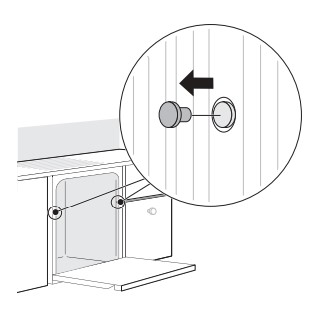
- Drive a wood screw through the mounting bracket and into the cabinet frame.
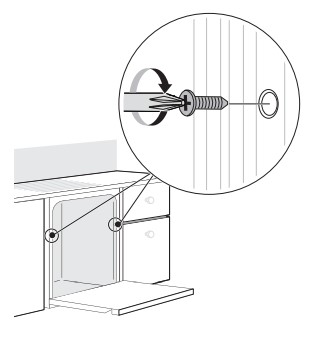
- Reinstall the plastic caps.
Final Installation Check
Check if the dishwasher is properly installed.
- Turn on the circuit breaker.
- Turn on the house water supply.
- Make sure that the door opens and closes smoothly.
- If necessary, level the dishwasher again.
- If the door will not close, make sure the rack is level.

- Make sure that all packaging materials have been removed.
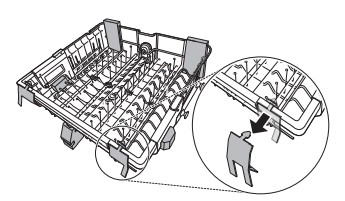
- Power on the dishwasher and run a Turbo cycle to verify proper operation.
- Check for leaks at the drain hose and water supply connection..
- If a water leak is detected, press and hold the Start button for 3 seconds to cancel the wash cycle and automatically drain the water from the dishwasher. Tighten all water connections and run another cycle. Repeat until no leaks are detected.
- Replace the lower cover
Installation Check Error Codes
Refer to the chart below before calling for service.
| Error Code | Possible Cause and Solution |
| OE Error | Drain hose is kinked or pinched. Feed the drain and water supply hoses through the hole under the sink. Then gradually slide the dishwasher into the cabinet while pulling on the hoses under the sink to take up any slack. This helps avoid kinking the hoses or trapping them beneath the dishwasher |
Drain hose is connected to the disposal without removing the knockout plug. Remove the knockout plug from the disposal. | |
Waste tee or disposal is clogged. Remove knockout plug on the waste tee or disposal. | |
| IE Error | Water supply line is kinked under dishwasher. Feed the drain and water supply hoses through the hole under the sink. Then gradually slide the dishwasher into the cabinet while pulling on the hoses under the sink to take up any slack. This helps avoid kinking the hoses or trapping them beneath the dishwasher. |
House water supply is not turned on. Turn the water faucet on. |
OPERATION
Using the Appliance
Before Using the Appliance
- Read the Important Safety Instructions.
- Connect to the hot water supply only. The water supply temperature should be a minimum of 120°F (49°C) for better washing performance and shorter cycle time.
- Follow the instructions for loading the dishwasher to ensure effective cleaning.
- Remove insoluble items such as bones, toothpicks, and pieces of paper while loading the dishwasher.
When loading the dishwasher
- Only load items that are dishwasher-safe.
- Remove solid, burned-on scraps from dishes prior to loading in the dishwasher.
- Place items with deep dish bottoms at an angle to help water run off and speed the drying process.
NOTE Do not load utensils that are not heat-resistant or have decorative metal trim.
Quick Start
- Load the Dishes
Scrape the dishes free of excess food, bones, and any other hard, non-soluble residue. Pull each rack out and load the dishes as described in this manual. - Measure the Detergent
Using the guidelines in this manual, fill the detergent cup with the recommended amount of detergent and close the lid. If a prewash is desired, the recess on top of the lid should also be filled with detergent. - Close the Door
- Turn on the Dishwasher
To turn on the display panel, press the Power button. - Check the Rinse Aid
The Rinse Aid icon will flash if the level of rinse aid in the dishwasher is low. Add rinse aid if the level is low to maintain the effectiveness of the dry cycle.
icon will flash if the level of rinse aid in the dishwasher is low. Add rinse aid if the level is low to maintain the effectiveness of the dry cycle. - Select the Cycle and Options Select the cycle and options that best fit the load by referring to the Cycle guide. The display will show the estimated time for the cycle and options selected.
- Operate the Dishwasher
Method 1: Press the Start button and then close the door in less than four seconds to operate the dishwasher. If the door is not closed within four seconds, the white LED with time flashes, an audible tone is heard, and the cycle does not start.
Method 2: Close the door first and then press the Start button to operate the dishwasher. If the door is opened during the cycle, the dishwasher will stop. To resume the cycle, see methods 1 and 2 above.
NOTE : If the door is opened during the cycle and is not closed within four seconds after selecting the Start button, or if the door is closed without pressing the Start button, the white LED with time flashes, an audible tone is heard, and the cycle does not start. - End of Cycle
When the cycle is complete, a chime will sound and the display will show End until the door is opened or Power is pressed. To save energy, press and hold High Temp for three seconds to set the End display to automatically turn off a few minutes after the cycle ends.
CAUTION: Do not open the door during operation or immediately after it has completed the wash cycle as the steam build up may cause scalding as the door is opened.
NOTE: Empty the lower rack first and then the upper rack. This will avoid water dripping from the upper rack onto dishes in the lower rack.
Auto-Off
The dishwasher automatically turns off after four minutes of inactivity if paused or if no cycle is started.
Control Panel

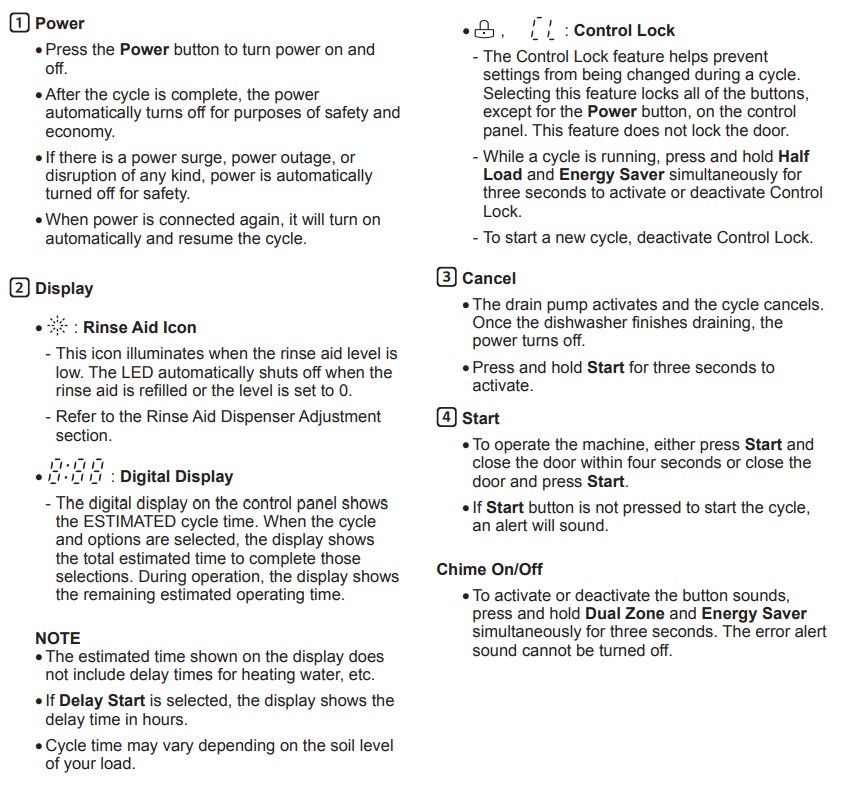
Cycles
Select your desired cycle.
Auto
This cycle senses the soil amount and soil toughness and is optimized to achieve the best cleaning.
Heavy
This cycle is for heavily soiled dishes and dishes with hardened on soil. The Heavy cycle defaults to the strongest spray intensity and uses it to wash heavily soiled dishes.
Delicate
Use this cycle to clean delicate items such as fine china and stemware.
Normal
This cycle is for moderately soiled, everyday loads. Select the Night Dry option if leaving dishes overnight. Press and hold Extra Dry for three seconds to activate Night Dry.
- After the cycle ends, the fan runs for an hour to help vent the warm, moist air in the tub. You can stop the fan by opening the door after the cycle ends.
Turbo
This cycle will clean heavily soiled dishes in an hour using slightly more energy and water.
- This cycle does not have drying. Select the Extra Dry and Night Dry option or another cycle for better drying.
Download Cycle
Use a dedicated cycle downloadable via Wi-Fi or NFC.
NOTE
- Only the cycle code for the current Download cycle appears on the appliance. See the smartphone app for cycle codes, names, and more information about the available cycles. -
- Default Cycle : P1. Pots & Pans
Machine Clean 
This cycle is for cleaning the inside of the dishwasher. Use the cycle without dishes in the machine. It eliminates residual soils, odor, white spots, and other dirt. Add citric acid or another cleaning agent for more effective results.
- Press and hold Heavy for three seconds to activate.
NOTE
- The Machine Clean
 icon flashes every 30 cycles. To activate or deactivate the icon, press the Delicate button for three seconds.
icon flashes every 30 cycles. To activate or deactivate the icon, press the Delicate button for three seconds.
Rinse
This cycle is a quick rinse for dishes that will not be washed immediately. The cycle rinses dishes that have excess soil to soften dried on residue. Rinsing the dishes helps prevent odors in the dishwasher. No detergent should be used.
- This cycle does not have drying.
- Press and hold Normal for three seconds to activate.
Express
This cycle will quickly clean lightly soiled dishes. (Time : 33 minutes)
- This cycle does not have drying. Select the Extra Dry and Night Dry option or another cycle for better drying.
- Press and hold Turbo for three seconds to activate.
Options
Select the desired cycle button and then select the options for that cycle.
Dual Zone
This option automatically sets the spray intensity to soft for the upper spray arm and strong for the lower spray arm. Place heavily soiled dishes like plates and bowls in the lower rack and lightly soiled dishes like cups and small plates in the upper rack to get the best results.
Half Load
This option washes intensively by selecting the upper or lower racks. For small loads, use just the upper or lower rack to save energy and time. By pressing the Half Load button, the settings  , and the cancellation of the Half Load option are available.
, and the cancellation of the Half Load option are available.
Energy Saver
This option saves energy by reducing the wash and rinse temperatures. Wash time is increased to maintain wash performance. Do not use this cycle with heavily soiled dishes.
High Temp
Raises the main wash temperature to improve cleaning.
Extra Dry
Select the Extra Dry option for better drying performance. This option adds extra drying time to the cycle and raises the heated rinse temperature.
When the rinse aid is empty, the Extra Dry option is selected automatically.
Night Dry 
Dishes are often left in the dishwasher overnight after the cycle ends. This can result in the steam inside the tub condensing on dishes, leaving them wet. The Night Dry option runs the ventilation fan periodically to help vent the steam from the tub.
- Press and hold Extra Dry for three seconds to activate.
- The Night Dry option is selected by default for all cycles for which it is available, except the Normal cycle.
- To add the Night Dry option to the Normal cycle, press and hold Extra Dry for 3 seconds.
Delay Start
The Delay Start feature delays the start of a selected cycle. Each time the Delay Start button is pressed, the delay time increases by an hour. The delay time can be set from 1 to 12 hours, in one-hour increments.
Cycle/Option Guide
The cycle guide below shows the available options for each cycle.

* Actual water consumption will vary depending on soil level and hardness of water.
** The actual running time and cycle time displayed may change depending on options chosen, soil level, water temperature, and hardness of water. Therefore, display time and actual running time can be different.
*** Energy Saver cannot be used at the same time as Extra Dry or High Temp.
 : Extra drying time only, no added high-temperature rinse.
: Extra drying time only, no added high-temperature rinse.
 : ON by default.
: ON by default.
Loading the Dishwasher
The extra tall tub allows loading of dishes, pans, or other utensils up to 14" high. For effective washing performance, always follow the following instructions.
- Remove large particles of food debris from plates including bones etc. before loading.
- Items with burnt on food should be soaked prior to loading in the dishwasher.
- Deep pots or dishes should be placed upside down.
- Make sure that all items do not touch each other.

Non-Dishwasher Safe Items
The combination of high water temperature and dishwasher detergents may damage certain items. Do not wash the following items in the dishwasher.
- Copper or anodised aluminium
- Hand painted silver or gold leaf crockery
- Wood or bone handled utensils
- Iron or non rust proof utensils
- Plastic items which are not dishwasher safe
- Expensive ware such as silver and dishes with golden rings
- Fragile item such as crystal glasses
Loading the Lower Rack
Loading 10 Place Settings
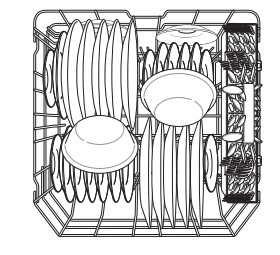
Loading 12 Place Settings
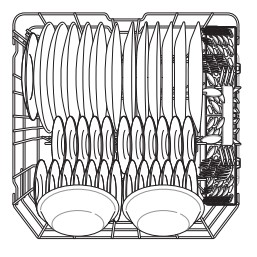
Lower Rack Loading Tips
- Plates should be positioned upright and facing the center of the rack and pots, pans and large dishes must be turned upside down.
- Load dinner plates, dishes, soup bowls etc. between the tines.
- Load cookie sheets, cake pans and other large items on the sides or back of the rack. Loading these items in the front of the dishwasher can prevent the water spray from reaching the detergent dispenser.
- Make sure that pot handles and other large items do not stop the rotation of the spray arms.
- The lower rack should not be used for small items such as cups, wine glasses, or small plates. These items should be loaded in the upper rack.
- Make sure that large items do not interfere with the rotation of the spray arms, and do not prevent the detergent dispenser from opening.
Folding Down the Lower Tines
Fold tines down to fit larger dishes; pull tines back up to fit smaller dishes.
Case 1
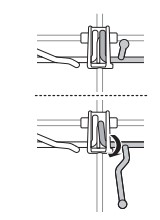
Case 2
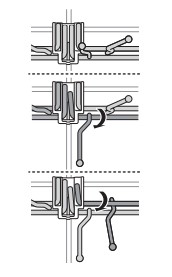
Loanding Dishes & Pots
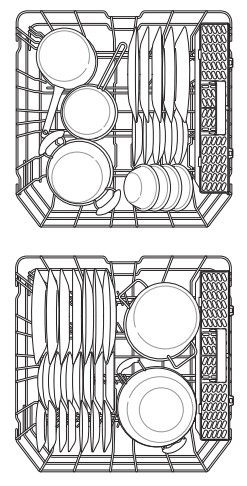
Loading Pots & Bowls
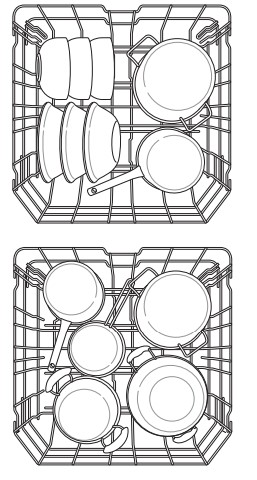
Note
- The silverware basket ships installed at the back of the bottom rack. For best performance, install it along the right side as shown.
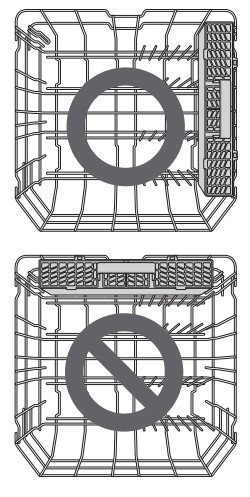
Loading the Silverware Basket
The silverware basket has separators to avoid scratching and tarnishing of delicate silverware.
Loading 10 Place Settings
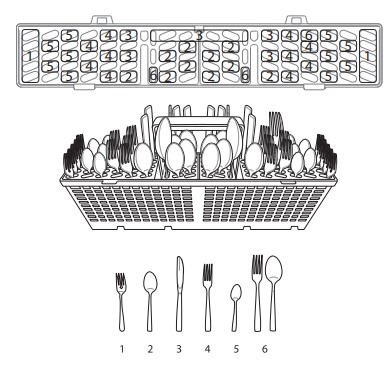
Loading 12 Place Settings
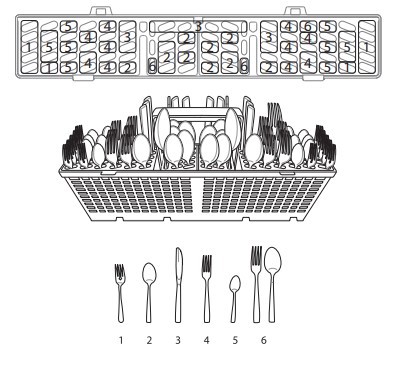
Silverware Loading Tips:
- For best cleaning results, use the top separators in the basket when loading silverware. The separators will prevent nesting of silverware.
- Load sharp items, such as knives, pointing down.
- When unloading the dishwasher, it is best to start with the silverware basket. Doing so will prevent water droplets from falling on your silverware from the upper rack.
Loading the Upper Rack
Loading 10 Place Settings
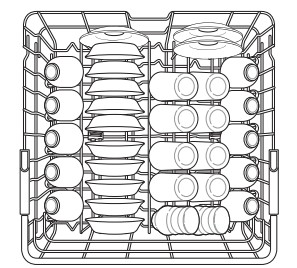
Loading 12 Place Settings

Upper Rack Loading Tips:
- Place cups and glasses in the rows between the rack tines. Placing them over the rack tines can lead to breakage and water spots.
- To avoid chipping, do not let stemware touch other items.
- Place items so that the open end faces down for cleaning and drying.
- Do not stack items on top of each other.
- Use the upper rack for small or delicate items such as small plates, cups, saucers, glasses, and dishwasher-safe plastic items.
- Cups, glasses, and bowls must be positioned upside down.
- Make sure items do not interfere with the rotation of the spray arms above and below the upper rack.
- When loading larger items in the upper rack, such as wine glasses or taller cups, it may be necessary to remove the cutlery rack if one is present.
Folding Down the Upper Tines
Fold tines down to fit larger dishes; pull tines back up to fit smaller dishes.
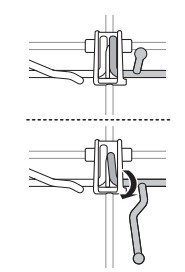
Loading Dishes & Pots
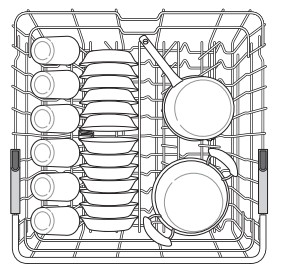
Height Adjustable Upper Rack
The upper rack adjusts up and down. Raise the upper rack to allow items up to 14” tall in the lower rack. Lower the upper rack to allow dishes up to 12” tall in the upper rack. The dishwasher ships with the upper rack raised. There are three available positions for adjusting the height of the upper rack to create more space.
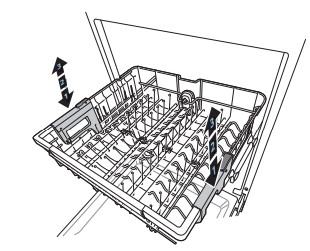
Lowering the Rack:
Hold the rack at the center of each side to support its weight. Then, push the button on each side to release the rack and lower it to the lower position.
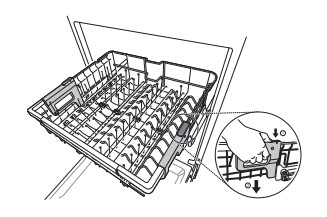
Raising the Rack:
Lift the rack at the center of each side until the rack locks into place in the upper position. It is not necessary to lift the lock levers to raise the rack.

NOTE
- Raise the upper rack without pushing the buttons on each side. Pushing the buttons when raising the rack will prevent the rack from locking into position.
- To set the rack to the middle position, it may be easier to lower the rack all the way down and then raise each side of the rack individually until it clicks into place.
- Before pushing the upper rack into the dishwasher, ensure the rack height is the same on both sides. If the height is not the same on both sides, the dishwasher door will not shut and the upper spray arm will not connect to the water inlet.
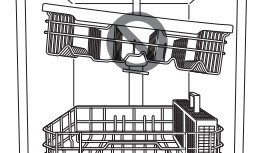
There is a 24 5 /8 inches (56 mm) gain in height when the upper rack is moved to the lower position. - After adjusting the rack levels, check that the spray arms are free to rotate.
- With the lower position of the upper rack, check if the bottom part of upper rack including spray arm is not disturbing items on the lower rack.
- When the upper rack is in the lower position, push in the upper rack first, and the lower rack later.
- Pull out the lower rack first, and the upper rack later.
- Raise the upper rack without pushing the buttons on each side. Pushing the buttons when raising the rack will prevent the rack from locking into position.
- To set the rack to the middle position, it may be easier to lower the rack all the way down and then raise each side of the rack individually until it clicks into place
Adding Cleaning Agents
Adding Detergent to the Dispenser
- Remove the label on the dispenser prior to running the dishwasher for the first time.
- The amount of detergent needed depends on the cycle, load size, and soil level of dishes.
- Put detergent into the detergent compartment before starting any cycle, except the Rinse cycle.
- Push the button on the dispenser lid to open the cover.
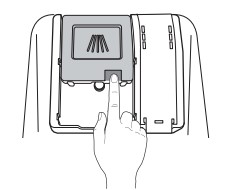
- Add dishwashing detergent to the main wash compartment until the level is between the lines marked 15 and 25.
- Fill to over the 25 line for hard water or heavily soiled loads.
- Fill to the 15 line for soft water or lightly soiled loads.
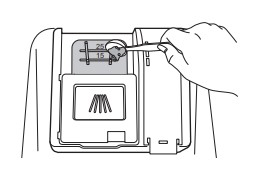
- Push the detergent lid to slide the lid closed until it clicks
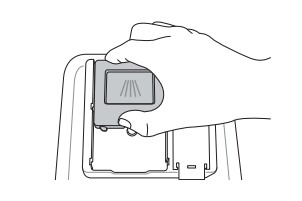
- If a prewash is desired, fill the recessed prewash compartment area on the lid with detergent.
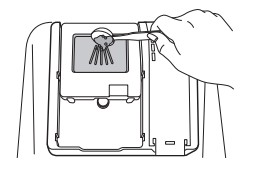
NOTE
- After completion of the wash program, check whether the detergent was completely washed out.
- Some dishwasher detergent tablets may become stuck in the dispenser due to their excessive size. Tablets can be placed onto the base of the wash tub next to the filter before starting the cycle.
- Too much detergent can leave a film on dishes and in the dishwasher, resulting in poor wash performance.
- If dishwasher detergent tablets are used without liquid rinse aid, the dishes and dishwasher interior will have excessive moisture. Select the Extra Dry option for better drying performance.
- Using liquid rinse aid improves drying performance by allowing water to drain off of dishes after final rinse.
- Do not use detergent tablets for shorter wash cycles. The tablet may not dissolve completely, causing detergent residue on dishes and inefficient cleaning.
- Using a wash booster helps remove spots, residue, and the white film caused by hard water. It does not help remove excess detergent residue.
Adding Rinse Aid to the Dispenser
The Rinse Aid indicator appears in the display when more rinse aid is needed. The use of rinse aid is recommended to prevent water spots on dishes and to enhance drying performance. 1
- Open the rinse aid lid by lifting up the flap.
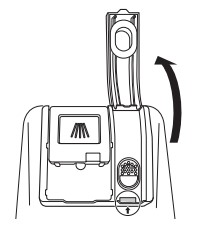
- Add a liquid rinse aid to the maximum fill level. The rinse aid should be settled in the dispenser while filling, or air bubbles may result in poor drying performance. Avoid overfilling the dispenser.
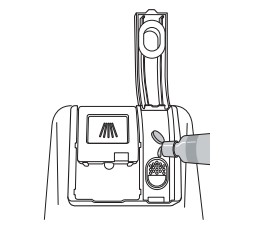
- Close the lid to lock the dispenser. Rinse aid is dispensed automatically during the final rinse cycle.
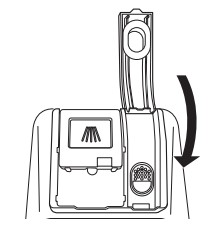
NOTE
- Only use liquid rinse aid in the dishwasher.
- Do not overfill the rinse aid dispenser.
- Wipe off any spilled rinse aid around the dispenser.
Rinse Aid Dispenser Adjustment
The dispenser has five adjustment levels. The dishwasher is programmed at the factory for a rinse aid dispenser level of 2. This can be checked and altered by using the buttons on the control panel.
- Ensure the appliance is off.
- Press Dual Zone and Power simultaneously to check the current setting.
- Press Delay Start to change the rinse aid dispenser setting. Each press of the button changes the setting one step from L0 to L4.
- Once the desired rinse aid dispenser setting is selected, press Start to save.
NOTE
- Adjust the setting higher if you have hard water and notice calcium buildup on your dishes.
- Setting the rinse aid control too low will contribute to spotting and streaking on dishes and poor drying performance.
- Setting the control too high can cause foaming, which will cause poor wash performance.
Refilling the Rinse Aid
How often the dispenser needs to be refilled depends on how often dishes are washed and the rinse aid setting used.
- The Rinse Aid
 icon flashes when more rinse aid is needed, unless the rinse aid dispenser setting is set to L0.
icon flashes when more rinse aid is needed, unless the rinse aid dispenser setting is set to L0.
SMART FUNCTIONS
SmartThinQ Application
The SmartThinQ application allows you to communicate with the appliance using a smartphone.
Installing SmartThinQ Application
Search for the LG SmartThinQ application from the Google Play Store on a smart phone. Follow instructions to download and install the application.
SmartThinQ Application Features
- For appliances with the
 logo
logo - The Tag On function can only be used with most smart phones equipped with the NFC (Near Field Communication) function and based on the Android OS (operating system).
Download Cycle
Download new and special cycles that are not included in the basic cycles on the appliance. Appliances that have been successfully registered can download a variety of specialty cycles specific to the appliance. Only one cycle can be stored on the appliance at a time. Once cycle download is completed in the appliance, the appliance keeps the downloaded cycle until a new cycle is downloaded.
Machine Clean Coach
This function shows how many cycles remain before It is time to run the Machine Clean cycle.
Smart Diagnosis™
This function provides useful information for diagnosing and solving issues with the appliance based on the pattern of use.
Settings
Set the Rinse Aid Dispenser Level, Machine Clean Reminder, Chime On/Off and Clean Indicator Light.
NOTE
- Press
 in the LG SmartThinQ application for a more detailed guide on how to use the Tag On function.
in the LG SmartThinQ application for a more detailed guide on how to use the Tag On function. - The location of the smartphone’s NFC module may vary depending on the phone, and NFC use may be restricted on some smartphones due to differences in transmission methods. Because of the characteristics of NFC, if the transmission distance is too far, or if there is a metal sticker or a protective case on the phone, transmission will not be good. In some cases, NFC-equipped phones may be unable to transmit successfully.
- The content found in this manual may differ from the current version of the LG SmartThinQ application, and the software may be modified without informing customers.
- NFC function would vary depending on smart phones.
Smart Diagnosis™ Function
Should you experience any problems with the appliance, it has the capability of transmitting data via your telephone to the LG Customer Information Center. NFC or Wi-Fi equipped models can also transmit data to a smartphone using the LG SmartThinQ application.
Smart Diagnosis™ through the Customer Information Center
- For appliances with the
 or
or  logo This gives you the capability of speaking directly to our trained specialists. The specialist records the data transmitted from the appliance and uses it to analyze the issue, providing a fast and effective diagnosis.
logo This gives you the capability of speaking directly to our trained specialists. The specialist records the data transmitted from the appliance and uses it to analyze the issue, providing a fast and effective diagnosis.
- Call the LG Electronics Customer Information Center at:
(LG U.S.A.) 1-800-243-0000
(LG Canada) 1-888-542-2623 - When instructed to do so by the call center, place the mouthpiece of the phone close to the Smart Diagnosis™ icon. Do not press any other buttons.
- Press and hold Download Cycle until a countdown displays on the appliance.
- Keep the phone in place until the tone transmission has finished.
- Once the countdown is over and the tones have stopped, resume your conversation with the call center agent, who will then be able to assist you using the information transmitted for analysis.
NOTE
- Smart Diagnosis™ cannot be activated unless the appliance can be turned on using the Power button. If the appliance cannot be turned on, troubleshooting must be done without using Smart Diagnosis™.
- For best results, do not move the phone while the tones are being transmitted.
- If the call center agent is not able to get an accurate recording of the data, you may be asked to try again.
- The Smart Diagnosis™ function depends on the local call quality.
- Bad call quality may result in poor data transmission from your phone to the call center, which could cause Smart Diagnosis™ to malfunction.
SmartThinQ Smart Diagnosis™
- For appliances with the
 or
or  logo Use the Smart Diagnosis feature in the SmartThinQ application for help diagnosing issues with the appliance without the assistance of the LG Customer Information Center. Follow the instructions in the SmartThinQ application to perform a Smart Diagnosis using your smartphone.
logo Use the Smart Diagnosis feature in the SmartThinQ application for help diagnosing issues with the appliance without the assistance of the LG Customer Information Center. Follow the instructions in the SmartThinQ application to perform a Smart Diagnosis using your smartphone.
NOTE
- Smart Diagnosis™ cannot be activated unless the appliance can be turned on using the Power button. If the appliance cannot be turned on, troubleshooting must be done without using Smart Diagnosis™.
MAINTENANCE
To maintain performance and prevent trouble, it is important to check the outside and inside of the dishwasher, including filters and spray arms, at regular intervals.
NOTE: If you have not used the dishwasher for a long time, refresh the inside by running the Machine Clean cycle without detergent. When the cycle is finished, clean the inside and outside of the dishwasher according to the Maintenance instructions.
Cleaning the Exterior
- In most cases, the exterior of the dishwasher can be cleaned with a soft damp cloth or sponge, then dried with a soft cloth. If the dishwasher has a stainless steel exterior, use a stainless steel cleaner
Cleaning the Interior
- Clean the interior of the dishwasher periodically with a soft, damp cloth or sponge to remove food and dirt particles.
- To remove white spots and odor from inside the dishwasher, run an empty cycle, without detergent, with one cup of white vinegar in a dishwasher safe glass or bowl placed on the upper rack. (Vinegar is an acid and with constant use it could damage the appliance.)
Seasonal Maintenance and Storage
- If you will be absent for an extended period of time during warmer months, close the water valve and disconnect the power supply line, or turn off the circuit breaker. Clean the filter, tub and dispenser to prevent odor.
- If you will be absent for an extended period of time during colder months and there is a possibility of freezing temperatures, winterize the water supply lines and the dishwasher itself. Winterization must be performed by qualified service personnel.
Clogged Drain Air Gap or In-Sink Disposal
Check the drain air gap or in-sink disposal if the dishwasher is not draining well.
Cleaning the Air Gap
- Turn off the dishwasher.
- Remove the air gap cover and the plastic cap underneath it
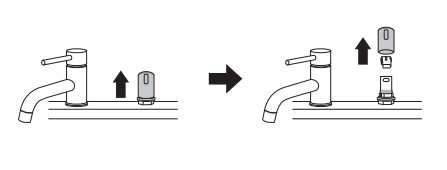
- Clean out any debris with a toothpick or brush.

- Replace the plastic cap and air gap cover
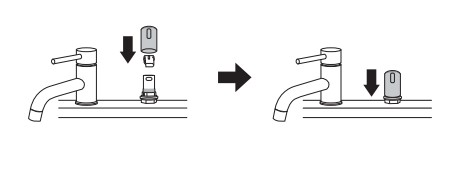
NOTE
- The drain air gap and disposal are external plumbing devices that are not part of the dishwasher.
- The warranty provided with the dishwasher does not cover service costs directly associated with the cleaning or repair of the external drain air gap and disposal.
Cleaning the Filters
- Remove the lower rack and position the bottom spray arm so a wider vee is open to the front.
- Turn the inner filter counter-clockwise and take out the assembled inner filter and stainless steel filter. With the filters removed, check the sump opening and remove any foreign materials, if needed.
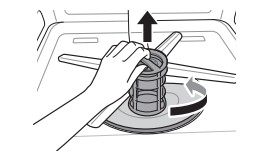
- Clean the filters with a soft brush under running water. Reassemble the filters before reinstalling them.

- To replace the assembled filters, position the spray arm so the wider vee is toward the front. Fit the filters back into the filter holder and secure them by turning the inner filter clockwise until it clicks into place.
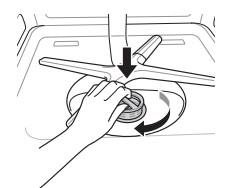
NOTE
- For best wash performance, clean the filter after each load. If food debris remains in the filter, it may cause an odor.
- In areas with hard water, clean the filter at least once a month with a soft brush.
- Clean the filters using non-abrasive materials and warm running water.
- Make sure the filter is assembled correctly before starting a cycle. When assembling, rotate it firmly until it clicks.
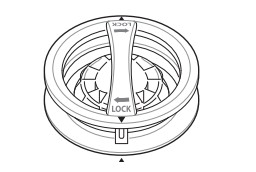
Recommended Filter Cleaning Schedule
| Number of Loads Per Week | If you wash dishes before loading | If you scrape and rinse dishes before loading | If you only scrape dishes before loading | If you do not scrape or rinse dishes before loading |
| 1-3 | Every 6 months | Once a year | Four times a year | Once a month |
| 4-7 | Every 6 months | Once a year | Four times a year | Twice a month (every 15 days) |
| 8-12 | Every 6 months | Every 6 months | Every 1.5 months | Every week |
| 13-14 | Every 6 months | Every 6 months | Every 1.5 months | Twice a week |
Cleaning the Spray Arms
If the spray arm holes are blocked by any food residue, dishes may not be cleaned well due to improper water spray. It is recommended that the spray arms be cleaned once every two weeks.
Cleaning the Lower Spray Arm
- Make sure that the water jet holes are not blocked by food particles.
- If any food residue blocks the spray arm holes, remove it with a pin or any sharp tool.
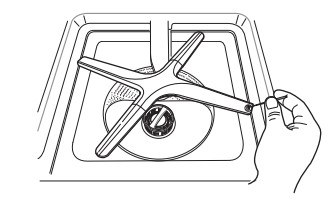
Cleaning the Upper Spray Arm
- Pull the upper rack forward. Make sure that the water jet holes are not blocked by food particles.
- When cleaning is necessary, remove the upper spray arm by turning the nut on the bottom of the spray arm 1 /8 turn counter-clockwise and pulling down.

- Remove food particles by rinsing or shaking the spray arm.
- If any food residue blocks the spray arm holes, remove it with a pin or any sharp tool.
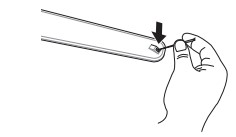
- After removing the food residue, clean the spray arms holes under running water.
- After cleaning the upper spray arm, press it up into place. Turn the nut 1 /8 turn clockwise to make sure that the nut locks back into place.

- After assembly, check whether the spray arms rotate freely
TROUBLESHOOTING
FAQs: Frequently Asked Questions
- Q: Does this dishwasher require a rinse aid to be used?
- A: Rinse aid is strongly recommended to enhance the drying performance of the dishwasher. In order to be more energy efficient, the hybrid drying system does not use a heating element to assist in drying, so a rinse aid plays an integral role in the drying process. If a rinse aid is not used, water may remain on the dishes and the tub. Rinse aid helps to ensure that the majority of the water has been sheeted off of the dishes at the end of the rinse and that the load is ready for the dry cycle.
- Q: What can be done if my dishes have a cloudy, white film on them after a wash?
- A: The cloudy film is usually caused by minerals in the water reacting with the dishwasher detergent. First, be certain not to use too much detergent. Refer to Adding Detergent to the Dispenser section for recommended detergent amounts. Add an extra rinse to the cycle. LG Dishwashers use less water than traditional dishwashers, so adding an extra rinse aids in rinsing the film away. If the water supply is hard, it may be necessary to add a performance booster that addresses the hard water condition.
- Q: How do I remove white film on the tub?
- A: Measure 3 tbsp. (40 g) of citric acid powder and use it to fill the main detergent compartment. Run a Machine Clean cycle. Do not use detergent.
- Q: What steps can I take to improve drying results?
- A: Drying performance is directly affected by the amount of heat that remains in the tub after the heated rinse is performed. If your dishwasher is far away from your home’s hot water heater, it may be necessary to run the hot water tap in the sink before starting a wash cycle, to ensure that cool water is purged from the hot water lines. This will ensure your dishwasher has a consistent supply of hot water from start to finish. Using the High Temp setting also aids in keeping the inner drum temperature and dishes hotter before drying begins. LG dishwashers are designed to be used in conjunction with a rinse aid. Using a rinse aid will maximize the amount of water that has already been sheeted away from the dishes before the dry cycle begins. If a rinse aid is used and the performance still needs a boost, adjust the amount of rinse aid used. 2 is the default setting, but if necessary set the level to 3 so more rinse aid is used. Water tends to bead rather than sheet off plastic and nonstick surfaces, making them more difficult to dry. If washing plastic items in a Normal cycle, select the Extra Dry or Night Dry option or both for better drying results. When the rinse aid is empty, the Extra Dry option is selected automatically. Allow the dishwasher to completely finish the dry cycle before opening the door. If the door is opened in the middle of the dry cycle, the heat that is necessary for the hybrid dry system to work will escape. This will cause all of the dishes inside to remain wet once the cycle finishes.
- Q: What is the hybrid drying system?
- A: The dishwasher does not rely on a heating element for the drying process; instead, it relies on the heat that is retained by the dishes and the tub during the wash and rinse cycles to turn the moisture in the tub into humidity. Warm, moist air in the dishwasher is then pulled into a condensing duct in the door by a fan. The air then cools, which causes the humidity to condense. Room temperature air is also drawn into the duct to help the air cool down faster. When this moisture condenses into a liquid, it is drained out.
NOTE Rinse aid is required to enhance the drying performance. If no rinse aid is used, water may remain on the dishes and the tub.
- A: The dishwasher does not rely on a heating element for the drying process; instead, it relies on the heat that is retained by the dishes and the tub during the wash and rinse cycles to turn the moisture in the tub into humidity. Warm, moist air in the dishwasher is then pulled into a condensing duct in the door by a fan. The air then cools, which causes the humidity to condense. Room temperature air is also drawn into the duct to help the air cool down faster. When this moisture condenses into a liquid, it is drained out.
- Q: Why am I hearing a whistling sound from the dishwasher?
- A: It is important to determine the duration of the noise and when it happens (what part of the cycle). When water is drawn into the dishwasher, a whistling noise can be heard. This is normal. If the water pressure is too high, it will be louder, so it may be necessary to adjust the water valve to lower the pressure if the noise is too loud.
- Q: What kinds of dishes can be placed in the dishwasher?
- A: Ensure that the dishes you place in the dishwasher are dishwasher safe. Plastic dishware will not dry as effectively as glass and metal dishware. Plastic items do not retain heat as well as glass and metal dishware. Plastic cups and dishes may require some hand drying before being put away at the end of the cycle.
- Q: Can I perform a drain only cycle?
- A: To drain standing water, press and hold Start for three seconds until the cycle stops. Once the dishwasher finishes draining, the power turns off.
- Q: Why does my dishwasher continuously chime if I open the door during a cycle or right after the cycle has finished?
- A: This is normal. The dishwasher is letting you know that the interior temperatures of the unit are hot and to use caution when placing your hands inside. Once the unit has cooled down, the chiming will stop.
- Q: What is Control Lock and how is it activated?
- A: Control Lock is a feature that prevents the controls from being changed during the cycle. It does not prevent the door from being opened or the unit from being powered off. To activate or deactivate, press and hold Half Load and Energy Saver simultaneously for three seconds.
- Q: Can I add an extension to the drain hose?
- A: If an extension drain hose is required, use 5 /8" or 7 /8" inside diameter, 2-3 ft. length hose and a coupler for connecting the two hose ends.
- Q: An LED is blinking, the machine is chiming, and the dishwasher won't start. What is wrong with the dishwasher?
- A: This is a safety feature. The door must be closed within four seconds of pressing the Start button. If the door is not closed within four seconds, an LED flashes, an audible alert sounds, and the dishwasher does not operate. To start the dishwasher, open the door and either close the door and press Start (front controls) or press Start and close the door within four seconds (top controls).
- Q: Before loading dishes, should I pre-rinse dishes?
- A: No, you don't need to pre-rinse the dishes before loading especially if using the Normal and Auto cycles. The dishwasher washes dishes clean without pre-rinsing.
Before Calling for Service
The appliance is equipped with an automatic error-monitoring system to detect and diagnose problems at an early stage. If the appliance does not function properly or does not function at all, check the following before you call for service.
- Dishwasher will not operate.
- Start button is not pressed.
- Press the Start button.
- Door is not completely closed.
- Make sure that the door is completely closed and latched.
- Power supply or power supply line is not connected.
- Connect the power supply or power supply line properly.
- Fuse is blown or circuit breaker tripped.
- Replace the fuse or reset the circuit breaker.
- Control Lock is activated.
- Deactivate Control Lock.
- Start button is not pressed.
- Dishwasher operates too long.
- Dishwasher is connected to cold water.
- Check the water supply connection or water heater setting. (Heating cold water takes longer.)
- Dishwasher is connected to cold water.
- Odor
- The previous cycle was stopped before completion and residual water remains in the dishwasher.
- Turn on the power, run the Cancel cycle option to remove the residual water, then run the Turbo cycle using detergent but with the dishwasher empty.
- There is food in the bottom of the unit or in the filter.
- Clean the filter and the interior according to the Maintenance section of the owner’s manual.
- Unwashed dishes are left in the unit for a long time.
- Cycle with one cup of white vinegar in a dishwasher safe glass or bowl placed on the upper rack. (Vinegar is an acid, and with constant use it could damage your appliance.)
- The previous cycle was stopped before completion and residual water remains in the dishwasher.
- Water remains in tub after completion of cycle.
- Drain hose is kinked or clogged.
- Adjust hose or clear blockage.
- Drain hose is kinked or clogged.
- Food soil remains on dishes.
- Improper cycle selection.
- Select correct cycle based on soil level and type of dishware being washed.
- Water temperature is too low.
- Check water supply connection or water heater setting.
- Dishwashing detergent was not used.
- Use recommended detergent.
- Low inlet water pressure.
- Water pressure should be between 20 and 80 psi.
- Water jet holes on spray arms blocked.
- Clean the spray arms.
- Improper loading of dishes.
- Make sure dishes do not block spray arm rotation or interfere with detergent dispenser.
- Filters are clogged.
- Clean filters.
- Improper cycle selection.
- Cloudiness on glassware.
- Combination of excessive detergent and hard water.
- Use less detergent and use a rinse aid to minimize the problem.
- Combination of excessive detergent and hard water.
- Black or gray marks on dishes.
- Aluminum items rubbing dishes during cycle.
- Reposition the dishes.
- Aluminum items rubbing dishes during cycle.
- Yellow or brown film on inside surfaces of dishwasher.
- Coffee or tea stains.
- Eliminate the stain by using a stain removal product.
- Coffee or tea stains.
- Spots and filming on dishes.
- Low water temperature.
- Water supply should be at least 120 °F for best wash performance.
- Overloading.
- Do not overload the dishwasher.
- Improper loading.
- See the Operation section.
- Insufficient water pressure.
- Water pressure should be between 20 and 80 psi.
- Insufficient detergent.
- Add the recommended amount of detergent. See the Operation section.
- Rinse aid dispenser is empty.
- Refill rinse aid dispenser.
- Hard water buildup in the tub.
- Remove all dishes, silverware and silverware holder from dishwasher. Only racks should remain in tub. For best results, use citric acid powder (can be found in canning sections of most grocery stores or online). Measure 3 tablespoons (40 g) of citric acid powder. Fill main wash compartment with measured powder. If you cannot find citric acid powder, pour approximately one cup (200-300 mL) of white vinegar into shallow bowl and place in upper rack. Run Machine Clean cycle. Do not use detergent.
- Low water temperature.
- Noise
- Some level of noise is normal during operation.
- Detergent cover opening.
- Drain pump at the beginning of drain cycle.
- The dishwasher is not level.
- Adjust leveling feet.
- Nozzle arm knocking against dishes.
- Reposition the dishes.
- Some level of noise is normal during operation.
- Dishes don’t dry.
- Rinse agent dispenser empty.
- Check and refill the rinse agent dispenser if empty.
- Rinse agent dispenser empty.
- Lamps do not illuminate.
- Power is not connected.
- Connect power supply.
- Power is not connected.
- Spray arms do not rotate smoothly.
- Holes of spray arms are blocked by food particles.
- Clean the holes of spray arms.
- Holes of spray arms are blocked by food particles.
- Upper rack is crooked.
- Rack is poorly adjusted.
- See the Height Adjustable Upper Rack section.
- Rack is poorly adjusted.
- Dishwasher continuously chimes when the door is opened, during or right after a cycle has completed.
- This is a safety measure. Contact with escaping steam or the hot contents of the dishwasher could result in injury.
- Close the door until the dishwasher and dishes have cooled down. The chiming will stop if the door is closed or the interior temperature has cooled.
- This is a safety measure. Contact with escaping steam or the hot contents of the dishwasher could result in injury.
- Dishwasher chimes if panel is touched during operation.
- Bumping into or touching the control panel during operation may result in a disabled button sound. Only the Power, Start, and Control Lock buttons are enabled during operation to prevent cycle settings from being changed inadvertently.
- Button sounds can be turned off by pressing and holding Half Load for three seconds.
- The end of cycle chime and safety alert sounds will still sound.
- Bumping into or touching the control panel during operation may result in a disabled button sound. Only the Power, Start, and Control Lock buttons are enabled during operation to prevent cycle settings from being changed inadvertently.
- Dishwasher did not finish cycle.
- Door was opened during cycle.
- If the door is opened during a cycle, the Start key must be pressed within 4 minutes or the machine turns off and all settings are lost.
- Door was opened during cycle.
- Leaking in front of unit
- Dishwasher not leveled properly.
- Verify the unit is level from side to side and from front to back. See leveling instructions in the Installation section.
- Wrong detergent used.
- If excessive sudsing is causing the leak, allow the foam to subside for 24 hours then clean the inside of the tub with milk.
- Dishwasher not leveled properly.
- P1, P2, P3, or P4 appears in display.
- The Download cycle is selected.
- This is not an error code. This code indicates the current Download cycle.
- The Download cycle is selected.
- n:#, U:#, d:#, t# appearsin display. (# = a number)
- Test mode is selected.
- This is not an error code. This code is used when testing the dishwasher. Power the unit off and on and the code will disappear.
- Test mode is selected.
- L0, L1, L2, L3 or L4 appears in display.
- Rinse Aid Level setting mode is selected.
- This is not an error code. This code indicates the current rinse aid level. For more information, refer to the Adding Cleaning Agents section.
- Rinse Aid Level setting mode is selected.
- CL appears in display.
- Control Lock is activated.
- This is not an error code. This code indicates that the control lock is activated. Press and hold Half Load and Energy Saver simultaneously for three seconds
- Control Lock is activated.
Error Codes
| Problem | Possible Cause | Solutions |
 | Water inlet problem. |
|
 | Drainage Problem. |
|
| Air gap or disposal is clogged. |
| |
| Filters are clogged. |
| |
 | Oversudsing caused by improper detergent, such as dish soap. Failure to level dishwasher. |
|
 | Water leakage |
|
 | Excessive Water supplied. |
|
 | Heater circuit failure. | |
 | Thermistor failure. | |
 | Motor trouble | |
 | Vario motor trouble |
See other models: LDT7808SS 49UK6090PUA LKIM08121V 65UM7300PUA OLED65C8AUA
